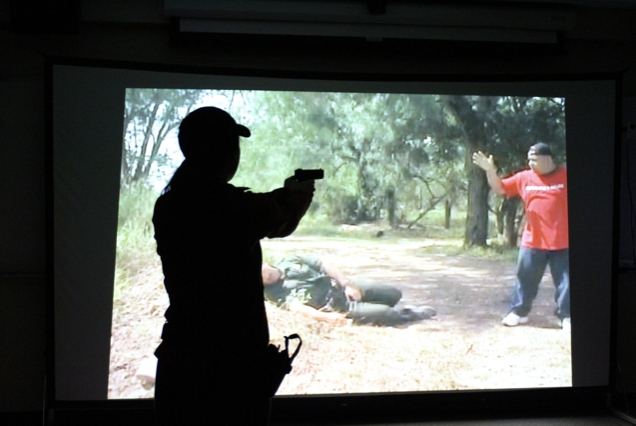
“Everything about today is real,” said Maggie Montgomery, the President of the Southern Oregon University Criminology Club. Earlier in March, the Crim department held their annual Crim Lock-in. This year, for the first time, they offered the seminar as a registered course for one credit in addition to the experience. Students, staff, faculty are invited to participate in activities such as the Oregon Physical Abilities Test (ORPAT) or learn defensive tactics.
Montgomery continued, “The ‘Shoot, Don’t Shoot’ Simulation is the real training the officers get, and during the forensics unit, you get to actually lift fingerprints. It’s learning and getting real training.”

With the assistance from law enforcement from Southern Oregon, the Criminology and Criminal Justice Department at Southern Oregon University hosted their annual Crim Lock-in on Friday, Mar. 2. Montgomery explained that the Lock-in is “really good exposure, for students, to the reality of how law enforcement works. It also helps them possibly network. Overall, it’s just good exposure to the criminal justice system, especially for someone who’s only read about things in textbooks.”

Students are offered a number of modules through which they can spend time with officers from different departments and law enforcement branches. One of the most popular is the Shoot-Don’t-Shoot simulation ran by Sergeant Jason Antley and Corporal Randy Jewell.
“‘The Shoot Don’t Shoot’ Simulation is really exciting and gets your blood pumping,” explained student participant Rosa Van Gordon. “I think it’s really important to see how stressful these scenarios can be and the quick thinking decisions that officers have to make on a shift.”
The Shoot Don’t Shoot Simulation was the authentic training process police officers go through. During the simulation, students worked through three different scenarios where they had to decide whether or not to shoot the suspects in the video. The students could communicate with the people within the video, and the fake gun registered exactly where the students shot within the environment. Before beginning Antley advised students to think, “Is what I’m about to do reasonable?”
The simulation included three different scenarios: an active response to a school shooter, a response to gun shots with an officer down, and a drunken man wandering around a park. All of the students participating during the 2:00 PM timeslot performed the scenarios in the exact same way, proving to Jewells and Antley that they knew the proper times to shoot at a suspect during a high stress situation.

The Criminal Justice Department, now chaired by David Carter, has run the lock in for now 17 years. The event started as an overnight lock-in, hence the name. However, it has since been streamlined as a benefit to the officers donating their time. Having been apart of the Lock-in for ten years now, he has seen the program evolve in more than just which modules are offered, “Seeing those transitions from student to officer is pretty fun.”
Officer Evan Westhelle of the Ashland Police Department is an SOU alum who went through the Lock-in program as a student before he graduated three years ago. After SOU, he was hired by APD, and has been with them for two and a half years in defensive and firearms training. “When I got hired on, I knew I wanted to step into some instruction roles, and when I go defensive tactics, I knew this was none of the things we did every year, so I reached out to Dr. Carter and Det Stewart who’s ran it for almost 15 year s now and made sure we got coordinated,” said Officer Westhelle. “I learned a lot about the law. Obviouly, you can’t teach everything about law enforcement– especially in a classroom setting, but it gave me a good background knowledge of the laws and esp when it comes the constitutional rights. That was the biggest step that SOU helped me with, especially going through the academy and having all the tests that we went through”

Although this was his first year as an instructor, having gone through the program as a student, the instructor used that prior knowledge to aid in teaching the Defensive Tactics module. “I knew what was boring what was fun, how to make stuff interesting, so I knew how to instruct to keep everyone engaged, keep it moving, keep it fun get everyone engaged and having a good time and learning something,” he said. “I like trying to get people out of their shell. At the very beginning everyone’s quiet, timid and you can start to see them warming up. A lot of that has to do with the instructor’s energy if the instructor is good, loud, moving around, they start to feel more comfortable.”
While the different modules sometimes cycle through, Officer Kimberly Budreau has been helping run the ORPAT at the Lock-in since the event’s conception. The test is required for anyone in Oregon wanting to participate in a law enforcement career. Officer Budreau described her favorite part of the event as being, “When people actually specifically ask what they can do to better themselves in this portion.” She continued, “I strongly feel that law enforcement officers should be in shape. Myself, I’ve had quite a few uses of force where I’ve been pushed into a position where I have to use force. If I don’t stay in shape and don’t stay on top of my physical abilities, I’m not gonna win that battle.”
Regarding the ORPAT, Carter explained, “We provide students with the opportunity to test their metal, that way they don’t see it for the first time when they get out there.”
At the end of the day, students, faculty, and law enforcement volunteers returned to the SU Arena to enjoy pizza and get a chance to discuss the day’s activities. According to Van Gordon, the Crim Lock-in showed how “police officers really are here to help and to support the community. One of the officers who taught the DUI unit wanted to come on campus and work at one of the resident assistant events. That just shows a little about their willingness to provide for their communities.”
One of Dr. Carter’s favorite aspect of the Lock-in is, “Seeing the students interact with the officers in a more relaxed way in the sense that, the law enforcement officers that come here and volunteer their time are engaged with the community and committed to SOU. So seeing the students more open to talk with them, breaking down those barriers that some individuals feel like they cant talk to the police, but they’re just people just like us– that’s really neat.”



